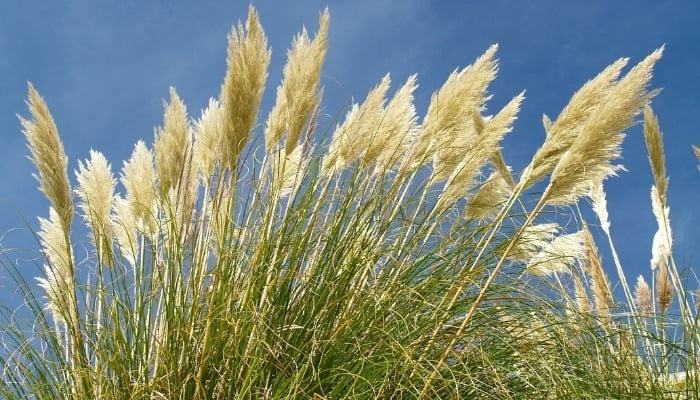Pampas grass is renowned for more than just its feathery blossoms. This attractive grass can reach heights of 10 to 13 feet when fully grown.
It’s the ideal screen for borders and to add some privacy to your patio, porch, and gazebo. As hardy as the grass is, it doesn’t like the damp conditions in the winter.
Does pampas grass die in the winter? Although pampas grass stops growing in the winter and appears to be dead, the plant is actually just dormant. The perennial pampas grass will come back to life as soon as the weather warms up in the spring. Tying stalks together will help prevent damage from frost and damp, cold weather.
Pampas grass needs proper pruning and care to ensure that it stays healthy and grows its delightful plumes year after year.
Read on to find out how to protect the grass in the winter and when to prune it.
Pampas Grass in Winter
As a hardy plant, pampas grass is not impacted much by cold weather. Even sub-zero temperatures will not prevent the grass from rebounding to life once the soil thaws and the air temperature rises.
However, the long stalks of the grass can be damaged in damp or wet winter conditions.
Winter care is crucial for keeping the plant healthy and preventing permanent damage to the stalks and roots.
Is Pampas Grass Perennial?
Native to South America, the ornamental pampas grass is a perennial plant. Although the heart of the plant dies in the first year, new shoots keep it alive for the next 10 to 15 years.
Where Does Pampas Grass Grow?
Pampas grass is native to Argentina, Brazil, and Chile. The perennial plant can grow up to 10 or 13 feet depending on the growing conditions.
It’s a mainly ornamental plant grown as a border screen or focal point in Zones 7-11.
Can Pampas Grass Survive Winter?
Pampas grass doesn’t die in the winter. It just goes into dormancy where it stops growing and looks for all intents and purposes to be dead.
However, once the winter is over and the weather improves, the grass starts growing again. Moisture is the mortal enemy of pampas grass in the cold winter months.
To help the grass survive the winter, you should tie the stalks together to prevent frost damage and cover small plants with mulch.
Postpone pruning until late winter or early spring to protect the heart of the plant against frost.

Pampas Grass Winter Dormancy
In the winter, the pampas grass stops growing altogether. This is a self-preservation mechanism to protect the stalks and roots of the plant from dying.
However, once the temperature rises, the plant will show new growth.
Ravenna Grass vs. Pampas Grass
Ravenna grass is native to Europe and South Asia. It’s a tall ornamental grass that reaches 13 feet tall.
Ravenna is sometimes referred to as hardy pampas grass because it is capable of thriving in northern regions where pampas can not.
Because of its aggressive growth rate, it’s the right plant to prevent soil erosion. However, it tends to become invasive, and local rules regulate growing it in some states.
Pampas grass is native to South America and averages between 10 to 12 feet tall. As a border plant, it provides privacy.
Common cultivars include Aureolineata, Evita, Monstrosa, Patagonia, Pumila, and Silver Feather Notcort.
When To Prune Pampas Grass
One of the best ways to encourage pampas grass to grow new shoots is to prune the old stalks, which by the end of the winter would be rotten.
You should postpone pruning pampas grass until the late winter to protect it against freezing during frosts or harsh winter conditions. If you prune it in the autumn, use mulch to cover it.
How To Cut Back Pampas Grass
By the end of winter, you can prune your pampas grass in preparation for spring growth. Start by making sure no wildlife is lurking between the tall stalks of the grass.
Use A chainsaw to hack through the tough stalks. Cut near the base, leaving about 5 inches of the stalks above the ground.
Sprinkle a balanced 10-10-10 fertilizer (this one is excellent) around the plant and water it thoroughly.
Related Questions:
Is Pampas Grass Invasive?
Pampas grass has a fast growth rate and is considered an invasive plant in at least one state, Hawaii. Some countries such as Canada, the UK, and Australia have banned it altogether.
You should check the local state regulations before planting pampas grass in your yard.
How Long Does Pampas Grass Take To Grow?
Pampas grass takes between 2 to 4 years to reach maturity. It will keep sending out new shoots every spring for the next 10 to 15 years even though the heart of the plant is dead.
Conclusion
Pampas grass goes dormant in the winter as the damp conditions cause the stalks to rot.
You should postpone pruning the grass until late winter to protect the roots against the frost and chilly conditions. Cut back the grass to about 5 inches above the ground, and fertilize it.

